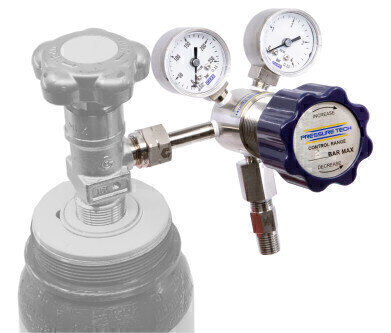Environmental Laboratory
High Accuracy Calibration with the MICRO300 Precision Regulator
Jan 11 2022
When producing a specialty gas mixture, most of the time taken to manufacture it goes into cylinder preparation to ensure that the mixture is stable. This is the single most important aspect in a quality gas mixture. If what comes out of the cylinder is not what is described on the label it will result in a poor calibration. Much time, testing, and research is invested in the development of techniques related to the interaction with cylinders and valves, solely to ensure the stability of mixtures.
If such time and effort is spent preparing a cylinder to handle a specific gas mixture, it begs the question: Why aren’t the regulator and gas delivery system treated with the same importance?
Most users will be familiar with material compatibility. That is, choosing between brass, plated brass, stainless steel, or special alloy, to ensure there will be no undesirable effects to the regulator or delivery system. Material selection is important both for reasons of safety and for accuracy in calibration.
Surfaces which have not been properly prepared will react with a gas mixture and change the composition. Imaging, by electron microscopy, of the surfaces of commonly used materials like brass or stainless steel illustrate how these surfaces are very uneven and have many crevices in which molecules can be lodged. These molecules can be exceedingly difficult to dislodge, which is a major factor contributing to the complexity of cylinder preparation.
Moisture is of particular concern as it is very prone to adhering to surfaces. It will react with nearly all commonly used reactive compounds including hydrogen sulphide, sulphur dioxide, and chlorine. Normal ambient air can contain up to 4% moisture content. If a regulator or delivery system has been exposed to ambient air, it is certain that there would be moisture contamination on all exposed surfaces.
Similarly, if your calibration mixture contains moisture it will adhere to any unprepared surfaces it meets. A similar result is known to occur with C6+ hydrocarbon compounds when they meet a surface while in the liquid phase.
Contamination of, reaction with, and surface adhesion of compounds in your gas mixture can be minimised by 1) Reducing the surface area: Reactions with wetted materials will always occur on a surface. Therefore, a reduction in surface area is also a reduction in potential adverse reactions. 2) Preparing the wetted surfaces: Reactions on wetted surfaces can be reduced by effective purging and/or with special coatings; or by 3) Reducing volume: Some gas mixtures are very high value so reducing the amount that is ‘wasted’ through purging saves money, especially over time.
CAC GAS, in partnership with Pressure-Tech UK Ltd, developed a specially designed regulator to address each of these areas. This regulator is designed with high-accuracy calibration in mind. The MICRO300 Precision Regulator features fully supported ‘sensitive’ pistons and a low internal volume to reduce wasted gas and minimise reactions. The regulator is available with or without SilcoNert® 2000 coating.
CAC GAS offers a full line of high precision gas control equipment along with our MICRO300 Precision Regulator. All items are kept in stock for fast shipment.
Digital Edition
AET 28.2 April/May 2024
May 2024
Business News - Teledyne Marine expands with the acquisition of Valeport - Signal partners with gas analysis experts in Korea Air Monitoring - Continuous Fine Particulate Emission Monitor...
View all digital editions
Events
Jul 30 2024 Jakarta, Indonesia
China Energy Summit & Exhibition
Jul 31 2024 Beijing, China
2024 Beijing International Coal & Mining Exhibition
Aug 07 2024 Beijing, China
IWA World Water Congress & Exhibition
Aug 11 2024 Toronto, Canada
Aug 25 2024 Stockholm, Sweden and online









.jpg)








